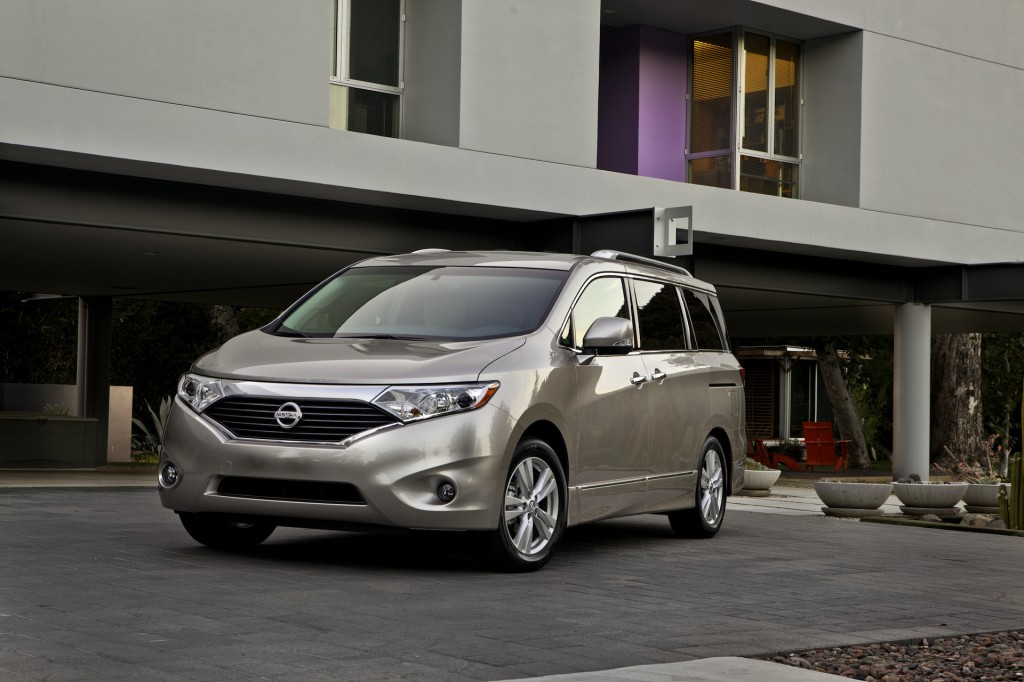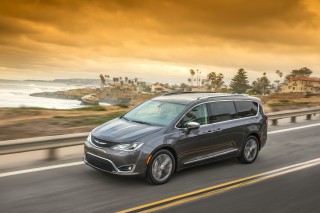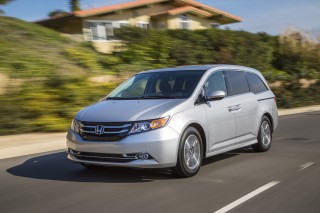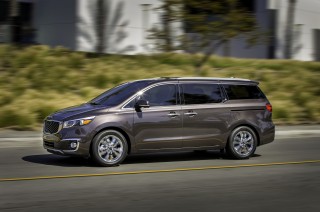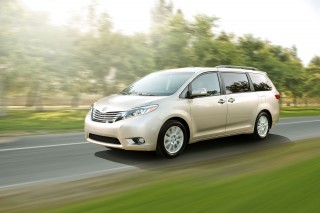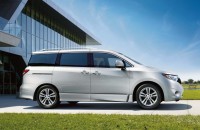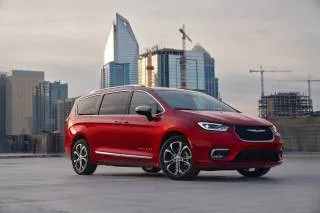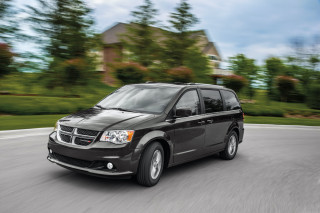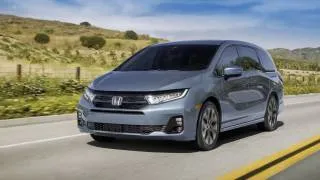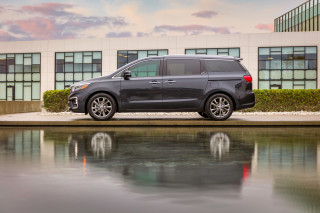Likes
- CVT is fairly responsive
- Smooth ride
- Steering feels direct
- It's boxy, but good-looking
Dislikes
- Confusing audio layout
- Seats don't fold away
- Less interior space than other minivans
- Sliding side doors don't open very wide
Buying tip
features & specs
The Nissan Quest may have the best road manners of any minivan, but it lags in safety and space, two musts for most minivan buyers.
The 2016 Nissan Quest minivan leaves us wanting. Despite its family-friendly intentions, the Quest's safety ratings are below average and its seating system is the least flexible on the market. It's more rewarding to drive than its competitors, but the Quest remains a difficult vehicle to recommend in this segment.
Depending on your expectations, you might find the Quest's design a little more adventurous than other vans. With an upright stance and lots of flared lines in front, the Quest's straight-edged passenger box bears more than a passing resemblance to the Ford Flex, mostly at its pillarless greenhouse and its almost vertical tail. The interior is more formal and less risky, with woodgrain trim on a plain dash that stacks some controls in counter-intuitive places. The audio knobs and switches, for example, are grouped into two locations, some to the right of the shifter, halfway out of sight.
The Quest's use of space is disappointing. It's still a big vehicle in the grander scheme, and front-seat passengers won't lack for leg or head room, or for storage of small items. From there, the Quest slips behind other minivans, first with sliding side doors that don't open wide enough to load in large people or objects. Second, it seats only seven while most rivals seat up to eight. The second-row seats fold forward, but don't disappear into the floor, and they can't be removed. The third-row seat folds flat, too, but stays in place while every other minivan's third-row seat folds away to create a flat cargo floor. A lot of usable space is lost in the process, and in a type of vehicle that places a priority on seating, space, and safety, it's a letdown. In all, the Quest has 35 cubic feet behind its third-row seats, 64 cubic feet with the third row folded, and 108 cubic feet with the second row folded. Most rivals top out at more than 140 cubic feet.
Performance? It's a highlight. A 3.5-liter V-6 coupled to a continuously variable transmission (CVT) is the Quest's only powertrain. It doesn't grumble as much here as it does in some other Nissans, and it's pretty perky for such a large vehicle. The steering has good feedback, the CVT has some programmed "shift" points to cut down on typically rubbery response, and body roll is tempered more than in other big minivans. In all, the Quest has the best handling of its kind, which follows its slightly more compact footprint.
Safety and features are areas where the Quest just doesn't compete. The IIHS says the Quest earns "Good" ratings for front and side impacts, but gives it "Acceptable" scores for roof crush and marks its "Poor" small-overlap crash performance as one of the worst the agency has seen.
The base van comes with the usual airbags and stability control, but all-wheel drive is not offered, and to get Bluetooth and a rearview camera—essential safety items, we think—you'll have to spend about $31,000. With major options—power side doors and a power tailgate, leather, satellite radio, and a DVD entertainment system—it's possible to spend more than $44,000 on Nissan's minivan.
The CVT helps make the Quest one of the most fuel efficient minivans on the market. The Quest delivers EPA fuel economy ratings of 20 miles per gallon city, 27 mpg highway, and 23 mpg combined. The combined number matches the new Chrysler Pacifica in combined mpg.
2016 Nissan Quest Styling
Upright and boxy, the Quest is kind of hip for a minivan, but it's still a minivan.
If you trek back through the Nissan Quest's previous generations, the current model may not come as much of a surprise. Each version has had a distinct style all its own, and this model is no exception.
From the outside, the Quest leans on its Japanese-market van roots, standing more upright and boxy than ever before. It has a faint resemblance to the Ford Flex from its profile, giving it some small amount of hip appeal, especially by comparison to some of its more curvaceous competitors. The nose looks lower and smaller, thanks in part to its large air inlets. The rear ends abruptly and harshly, intended for better aerodynamics, and large taillights make this one easier to tell apart from other vans in the dark.
Inside, the Quest keeps more to the standard minivan passenger-friendly and utilitarian themes, though it feels almost modern-retro Japanese with its plain-looking LCD displays and stacking of rectangles. There's a mix of wood and shiny gray plastic trim pieces throughout the interior, making the Quest feel a little upscale at times, and a little unfinished at others. The transmission lever lines up vertically on the center stack, and it blocks the driver's view of some knobs and buttons.
Atop these controls, Nissan parks an LCD screen. The screen offered on mid-level models is a 5.0-inch LCD. On top models the screen grows to 8.0 inches and incorporates more audio and navigation controls. A deck of buttons sits at the screens’ feet, piano-key style. If you're not accustomed to playing, you'll wish you'd studied as you figure out the Quest's audio controls.
2016 Nissan Quest Performance
The Quest offers the best acceleration and steering feel in a minivan, but some may not like the sluggish CVT.
As minivans go, we'd say the Quest is fun to drive. It doesn't feel as big as it looks, and the steering is better than its competitors.
With an independent suspension at all four corners, the Quest benefits from a smaller footprint than other minivans. It feels the most nimble of all its competitors, and in big part, that's due to the electrohydraulic steering. Using signals to direct the power steering's hydraulic pump instead of a belt, the Quest delivers the most natural steering feel of its class. While the electronic power steering in the Toyota Sienna is quite good, it doesn't rebound from inputs with the same relaxed feel.
That said, the Quest still a minivan, and as direct as its steering can be, and as well as it damps out road surfaces, it corners and accelerates with almost nothing but safety in mind. It doesn't bound over long bumps like the Chrysler minivans, though, and its near-equal curb weight seems to be damped more effectively.
The Quest is powered by Nissan's 3.5-liter V-6, which produces 260 horsepower and 240 pound-feet of torque. It's a little smoother and little quieter than most of the cars in the lineup with the same engine, and the minivan never feels strained for power.
Even the continuously variable transmission (CVT) works well here, thanks in part to Nissan's D-Step shift logic. While CVTs often feel sluggish to respond and amplify noise and vibration, the stepped "gears" help it feel fairly responsive in the Quest. Then again, minivans don't require, or even encourage, sporty driving, so sometimes slow CVT responses to throttle inputs aren't a concern.
2016 Nissan Quest Comfort & Quality
The Quest doesn't offer the smart cargo and seating package of the best in class, though it is still quite purposeful.
The Quest lacks some of the usefulness that we expect from a family vehicle.
The trouble starts in the second row, where the Quest's sliding side doors don't retract enough for adults to clamber up and into the seats with ease. It can be difficult to maneuver a car seat into the opening, never mind kids with minds of their own. The Quest lacks a middle seat position, which means the other eight-passenger minivans have a one-seat advantage over it. The Quest's third-row seat is cramped for adults, acceptable for kids.
In either the second or third rows, the seats themselves are nicely angled and supportive, but they don't move. The seatbacks just fold over when more cargo area is needed. That, plus a relatively high load floor, make the Quest feel small inside. The seats fold easily enough, thanks to levers and pull straps. However, if you order the power assist for the third-row seat, know that it stops short of raising the seat all the way. Oddly, it gives up at the vertical position, leaving owners to use a cloth strap to finish the job.
The seats don't store in the floor, and that cuts into cargo volume. In all, the Quest has 35 cubic feet behind its third-row seats, 64 cubic feet with the third row folded, and 108 cubic feet with the second row folded. The new Kia Sedona has folding second-row seats like the Quest, but still offers up 32/80/142 cubic feet of space, respectively. The Chryslers have their class-leading, fold-in-the-floor seats on some models, and with them, they can boast of 33/83/144 cubic feet. The humongous Sienna's numbers are 39/87/150 cubic feet of space with the second-row seats folded up and the third row tucked away. The Odyssey is almost as big, with 38/93/149 cubic feet of space behind the respective rows.
Other compromises are less noticeable, but they're there. There's no telescoping steering wheel, though the high seating position makes the most of the situation. The Quest offers up 16 cup and bottle holders, but the pop-out pair under the radio are big enough only for cans.
In terms of overall length and wheelbase, the Quest isn't that much smaller than the Chrysler minivans, the Toyota Sienna, or the Honda Odyssey. At 200.8 inches long, on a 118.1-inch wheelbase, it's reasonably close to those competitors in almost every dimension. Where it loses out is interior volume. Its fixed seats take up space where a good fold-away third-row seat would leave a flatter cargo floor, and where the Chrysler vans' fold-away second-row seats would win the functionality wars, every time.
The Quest has few other flaws. Up front, there's ample leg room and head room, and large adults will fit comfortably in its plushly upholstered buckets. The view ahead reminds us a lot of the first Japanese minivans that came to the U.S. in the 1980s, with a flat dash structure that makes for easy entry and exit, along with wide doors.
2016 Nissan Quest Safety
The 2016 Nissan Quest doesn't deliver the solid crash-test scores most families would want.
The Nissan Quest hasn't been rated by the government and its ratings from the IIHS are unimpressive. The Quest gets the top rating of "Good" in the moderate front overlap and side-impact crash tests, but it earns an "Acceptable" rating in the roof strength test, the lowest in the segment, and a "Poor" rating in the small front overlap test. In fact, the IIHS called it one of the worst performances yet in the 40-mph small overlap test, which simulates an impact with a telephone pole. Those scores prevent the Quest from earning the IIHS' Top Safety Pick designation, a key for a vehicle in such a safety-conscious segment.
The Quest does have a decent amount of standard safety equipment, though it's far from class-leading. Anti-lock brakes, traction and stability control are standard, as are dual front, side, and curtain side airbags. A rearview camera is standard on the top three trim levels, with a surround-view camera on the Platinum model. The Platinum also has a blind-spot monitors.
Tire-pressure monitors are standard as well, and Nissan's are unique in that they beep a warning at drivers when a tire is low.
2016 Nissan Quest Features
Order it with the features that you would want in a minivan and the Quest easily tops $30,000.
The 2016 Nissan Quest comes with all of the expected options for a minivan, making it a well-equipped vehicle for the segment, but not necessarily one that lives on the cutting edge. Trim levels include S, SV, SL, and Platinum.
Every Quest comes with power windows, locks, and mirrors; an AM/FM/CD changer (a dying breed); climate control; and keyless ignition. The base model doesn't offer some nearly ubiquitous features at all. For instance, there is no option at all for satellite radio, a rearview camera, or Bluetooth.
The Quest SV is the most popular model and our recommendation, since it bundles the most convenient features at the lowest price. Starting from the low-$30,000s, this model has standard Bluetooth, a USB port, power sliding side doors, a rearview camera, automatic climate control, and a 4.3-inch LCD audio display. The audio system deserves some study before buying. It's split into two locations, with some controls clustered under the LCD screen, and the rest tucked away near the gear selector. It can be confusing to scroll through audio functions up top, and to select radio presets and volume levels below.
In the $35,000 range, the Quest SL verges on luxury territory, with standard 18-inch wheels, power tailgate, leather seating, a power front passenger seat, heated mirrors, heated front seats, and automatic headlights. At nearly $44,000, the Quest Platinum gains a standard navigation system, satellite radio, power assist for the third-row seat, a DVD entertainment system with a sharp 11-inch screen, blind-spot monitors, a surround-view camera system, and xenon headlights.
The Quest offers few options. The DVD player is available for the SV and SL, while a Bose speaker package is offered for the SL. Satellite radio is offered on mid-line Quests. Dual sunroofs are available on the SL and Platinum models. The Quest has mostly skipped other cutting-edge luxury features, like Chrysler's Uconnect wireless hotspot or Toyota's wide-screen DVD entertainment system.
2016 Nissan Quest Fuel Economy
The CVT helps the 2016 Nissan Quest rank among the leaders in the segment.
Transmission updates for the 2015 model year made the Quest one of the most fuel efficient minivans on the market. At that time, Nissan gave its continuously variable transmission new shift logic and simulated stepped "gears."
As a result, the Quest delivers EPA fuel economy ratings of 20 mpg city, 27 highway, 23 combined. Comparably, the Honda Odyssey manages 19/28/22 mpg on the same cycles. It should be noted that the Odyssey offers cylinder deactivation and the Quest doesn't.
Chrysler's newest Pacifica manages the same 23 combined mark, but will surpass the Quest when it releases a plug-in hybrid version of the Pacifica later this year.
